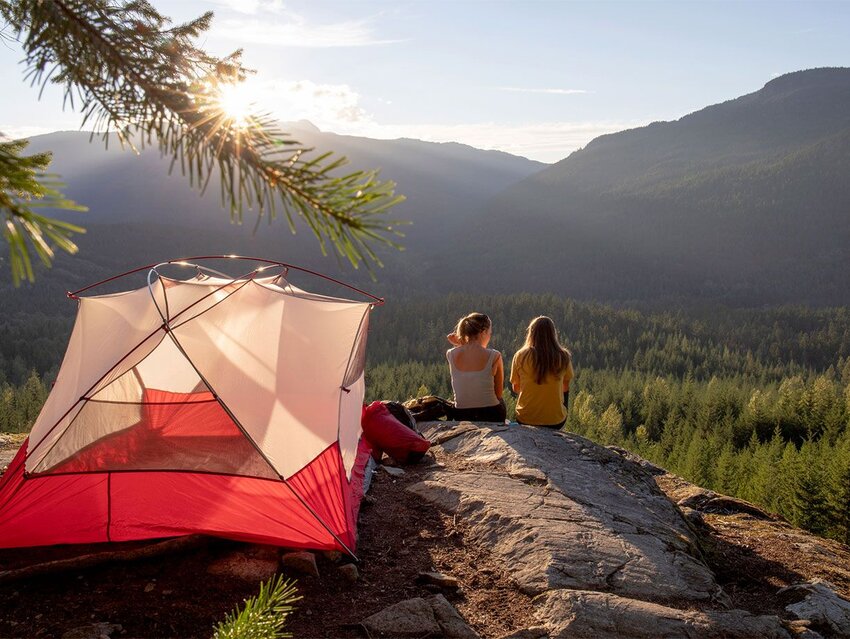Nature lovers have enjoyed recreational camping since at least the turn of the 20th century, and the past 100 years have led to endless advancements in the pastime — and with that came a whole new set of terminology. The word “camp” itself comes from the Latin campus, meaning “open field,” but today we know that camping is done just about anywhere, from backyards to mountaintops and everywhere in between. Let’s take a look at some quintessential camping terms before your next trip to the great outdoors.
Backcountry
The backcountry is a remote, undeveloped area used for camping or sports and can be found in national parks to rural campsites. Backcountry skiing, for example, is a popular wintertime activity done on unmarked or unpatrolled trails. “Backcountry” is the opposite of “frontcountry,” a newer term that refers to outdoor areas that are easily accessible by vehicles and often used by day visitors.
Tinder
The dating app borrowed from this camping terminology for the material used to start a fire. These flammable materials include leaves, bark, pine needles, and cotton. Tinder is not to be confused with kindling, which is larger than tinder and consists of small twigs and branches. “Tinder” comes from the ancient, Proto-Germanic term tund, meaning “ignite.”
Billy
Folks camping in a tent will want to have a billy — a metal container used to boil water over a campfire. The term comes from Down Under in Australia, but its origin is disputed. It might have come from the Aboriginal word billa, meaning “water,” or possibly from “bouilla,” a type of beef and vegetable soup in England.
Blaze
Hiking is one of the most popular camping activities, so knowing some basic trail lingo is a must. “Blaze” is another word for a trail marker. These paint swatches are used to mark official paths, typically on trees or rocks, and different colors indicate types of trails. The Appalachian Trail, for example, is marked with trail blazes. This is also where the term “trailblazing” (introducing new ideas) comes from.
Mummy Bag
It’s not just for Halloween — a mummy bag is a type of sleeping bag that fits snugly around the body. Campers love these in cold weather because they hold in warmth. When these bags are fully closed, only the inhabitant’s eyes and nose are visible, giving the bag a “mummy” vibe. The term “mummy” itself comes from the Arabic word mumiyah, meaning "embalmed body."
Boondocking
“Boondocking” or “dry camping” is a type of RV camping that happens when the vehicle is not connected to water, sewer, or electricity. The word “boondocks” itself, referring to a remote or wild place, comes from the Tagalog word bundok, meaning "mountain."
Noggin
It’s a nickname for the head, but it’s also the name of a small cup or a mug. The 16th-century word traditionally meant a quarter of a pint. Its origin could be from the word “nog,” which describes a strong English ale.
Anorak
An anorak is a waterproof, hooded jacket, usually worn in colder or rainy weather. It’s popular among campers because it is well lined and holds warmth. The term originated in Greenland from anoraq, the Eskimo word for this type of jacket.
Gaiter
Gaiters are great to have while camping in unfavorable weather. They’re waterproof pieces of cloth that cover the area around the ankle (between the tops of the shoes and the pants — think socks without the feet). There are gaiters made for hiking, mountaineering, fishing, and trail running. The word, adopted from the French word guêtre, meaning “peasant attire,” has been used in this way since 1775, meaning a “leather covering for the ankle.”
Glamping
A portmanteau of “glamorous” and “camping,” glamping is, as its name suggests, tent camping, but in style. Glamping experiences have been popping up around the world, usually in yurts (circular, domed tents) or upgraded cabins with electricity, beds, and water.
Bivouac
A bivouac (pronounced bi-voo-ak) is a temporary shelter or camp. It’s a French loanword of military origin — a term that essentially meant “to stand guard” in the face of impending danger. In modern camping, a bivouac typically consists of a tarp and a sleeping bag (no tent). “Bivy sack” is short for a bivouac sack. It is a lightweight, waterproof sleeping bag and is often used by climbers.
Guyline
These cables are attached to the rain fly (the waterproof cover over the tent) and staked into the ground to keep the tent secure. The term as used in camping contexts has been around since the 17th century, but its origin goes back to the Old French term guier, meaning “to guide.”
Haversack
A haversack is essentially a backpack with only one shoulder strap. Before it became popular in camping, it was used in the military as a bag for extra clothing and rations. It comes from the German word for “oats” (haver), meaning “oat sack.”
Potable Water
Potable water is safe for drinking, an important distinction from non-potable water (not safe for consumption), especially while camping. There are usually signs around water sources to tell campers what is safe to use for drinking, cooking, and bathing. It comes from the Latin word pōtā(re), meaning “to drink.”
Switchback
A switchback is a zig-zag trail or road that goes up the side of a steep mountain. Rather than going straight up, it switches back and forth using sharp bends running perpendicular to the slope of the mountain, making it easier to traverse.
Featured image credit: AscentXmedia/ iStock

